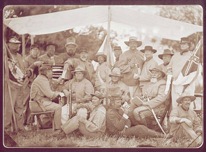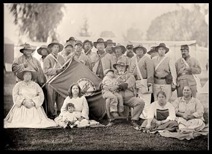Norfolk Light Artillery Blues Lot
Elmwood Cemetery
2nd Alley West, Lot 22


The Norfolk Light Artillery Blues was originally formed in 1829 as a state militia company and prestigious social club. The militia served through the entire Civil War and was one of the few military units that actually increased in size during the conflict. The Blues took an oath to never surrender and did not lose a single man to desertion throughout the course of the war.
Although they originally took their name from the dark blue uniforms worn by the unit, the Blues adopted Confederate gray and butternut when these became the approved Confederate Army colors after the battle of Bull Run. Later in 1861, the Blues received the designation of Grandy's Battery (after Charles Grandy, Captain of the battery) and were identified as such in official Confederate records from that time forward.
The Blues first served as a coastal unit on the Virginia Peninsula, where they engaged hostile craft in the defense of Norfolk. After the Seven Days, they were assigned to D.H.Hill's Department, south of the James River where they bombarded Union forces at Harrison's Landing. Lee next ordered the Blues to the Fredricksburg area where they were assigned to Anderson's division of Longstreet's Corps. They fought with Anderson's command at Fredricksburg and Chancellorsville. When Lee reorganized his army after Jackson's death, the Blues were assigned to Heth's division of A.P. Hill's III Corps. They fought at Gettysburg as part of Garnett's battalion and in the Wilderness the next year as part of Richardson's. They were also part of the Confederate defense of Petersburg during its siege and were present at Appomattox.*
The Norfolk Light Artillery Blues Lot was restored in 1990 through the hard work and dedication of the Pickett-Buchanan Chapter of the Daughters of the Confederacy and Battery B, 111th Field Artillery, Virginia National Guards (Norfolk Blues).
Of those buried on the Blues lot, we know the following:
On March 31, 1866, the remains of five Norfolk Light Artillery Blues veterans of the Civil War arrived by train from Petersburg. They were escorted to the MacArthur Memorial (then Norfolk’s Courthouse) and laid in state. On Sunday, April 1st, friends and relatives arrived at the courthouse to decorate the coffins and prepare to join the long cortege to their final resting place.
Ignatius Higgins, age 21, died of wounds in July 1864 at Chimborazo Hospital in Richmond. His mourners, with Father O’Keefe, placed him in the Catholic cemetery vault for later interment. R.M. Butler, age 30, died July 30, 1864 from wounds received at the Crater and his group left the cortege at Cedar Grove and his body was placed in the vault of his wife’s family, the Sheppards. The remains of J.S. Sterrett, 20, died June 14, 1862 in Petersburg; A.M. Watters, age 20, killed June 24, 1864 near Petersburg; W.C. Land, 20, killed May 1, 1863 at Chancellorsville and W.A. Wilkins, 22, died August 7, 1862 of typhoid fever in Petersburg hospital are also among the first veterans laid to rest on the Blues Lot. James Wilkinson, a Blues veteran who lived to 1907 was buried there as well. Research is still ongoing to ascertain the names of the other 13 interments.
*The National Civil War Association www.ncwa.org
Biographical information provided by Norfolk Bureau of Cemeteries.
Visitor Information
Visitor Hours: Sunrise to Sunset
Office hours: Monday to Friday 9:00 AM to 4:30 PM
Free parking inside cemetery.
Admission Cost: Free
Address: 238 E. Princess Anne Road , Norfolk, VA 23510
Official web site for more information: www.norfolk.gov/cemeteries
Norfolk Society for Cemetery Conservation Web Site: www.norfolksocietyforcemeteryconservation.org
